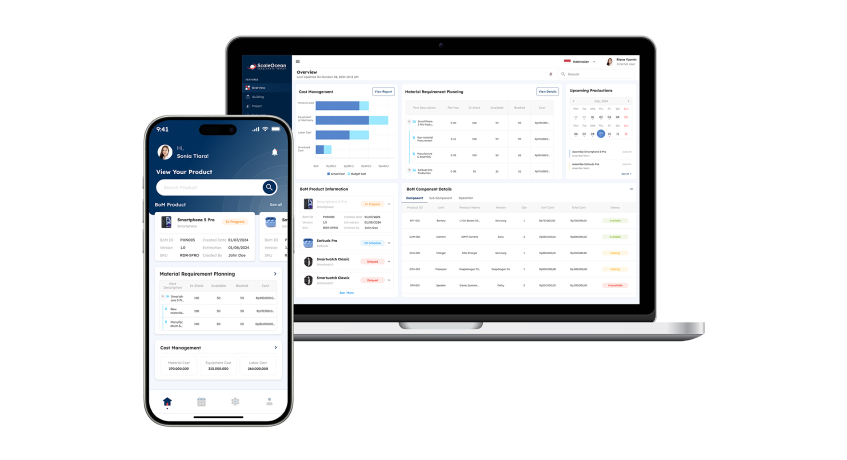The Singaporean manufacturing sector is at the forefront of adopting Internet of Things (IoT) technology to boost efficiency and maintain a competitive edge in the global market. Through real-time data collection, predictive analytics, and smart automation, IoT empowers manufacturers to minimize downtime, increase productivity, and optimize resource management.
From smart sensors tracking equipment performance to AI-driven demand forecasting, IoT is converting conventional manufacturing processes into responsive, data-driven ecosystems. Singapore’s thriving digital economy and robust digital infrastructure have helped accelerate the use of automation technologies and other forms of manufacturing technology adoption. The Singapore IoT market is estimated to reach $2.9 billion by 2025, growing at a CAGR of 24.92%.
As companies face increasing pressure to meet demand while keeping costs low, using IoT technologies plays an important role to obtain long-term success. Nonetheless, how precisely can IoT in manufacturing increase efficiency? The article discusses further its main benefits, which include real-time monitoring, predictive maintenance, supply chain optimization, and energy savings, allowing manufacturers to confidently navigate Industry 4.0.
- IoT (Internet of Things) refers to a network of interconnected devices that collect and share data, enabling real-time monitoring, automation, and data-driven decision-making.
- The adoption of IoT in manufacturing offers significant benefits, including increased productivity, cost savings, and enhanced operational agility, helping manufacturers stay competitive.
- Key challenges in IoT adoption include integration with legacy systems, data security concerns, high implementation costs, and the need for skilled professionals to manage IoT solutions.
- ScaleOcean offers IoT-driven solutions that help manufacturers optimize production, reduce inefficiencies, and improve predictive maintenance

What is IoT?
The Internet of Things (IoT) is a network of interconnected physical devices equipped with sensors, software, and technologies that collect and share data over the internet. Emerging in the early 2000s, IoT began with basic machine-to-machine communication and has since evolved into a sophisticated system driving automation and real-time data analytics.
IoT was initially used for tracking and remote monitoring, but it today benefits industries such as manufacturing, healthcare, and smart cities by boosting efficiency and decision-making. As businesses use IoT for predictive maintenance, supply chain optimization, and smart operations, its influence expands, revolutionizing how organizations operate in the digital age.
How is IoT Used in Manufacturing?

IoT is revolutionizing manufacturing by boosting efficiency, reducing downtime, and enhancing product quality. With smart sensors, automation, and data analytics, manufacturers optimize operations, cut costs, and make informed decisions. Real-time monitoring, predictive maintenance, and streamlined supply chains drive productivity and competitiveness in an evolving industry.
1. Smart Sensors and Devices
Manufacturers use IoT-enabled sensors to track equipment performance, monitor environmental conditions, and detect anomalies in production. These sensors provide real-time data on machine health, inventory levels, and product quality, reducing downtime and waste. By leveraging predictive analytics, companies can prevent equipment failures and maintain consistent production output while ensuring high-quality standards.
2. Automation and Control
IoT automates manufacturing by allowing machines to interact and respond to real-time data. Without requiring human participation, automated systems adjust production schedules, control machinery settings, and optimize operations. This lowers errors, boosts efficiency, and improves worker safety. Manufacturers may reduce operational expenses and accelerate production cycles by adopting IoT-driven automation.
3. Data Analytics
IoT generates immense amounts of data, which manufacturers may use to optimize processes and make better decisions. Real-time analytics help identify inefficiencies, predict maintenance needs, and enhance supply chain management. By using data-driven insights, manufacturers can streamline operations, reduce costs, and improve overall productivity, leading to higher profitability and competitive advantages.
Benefits of IoT in Manufacturing
IoT in manufacturing delivers significant benefits, from boosting efficiency and reducing costs to improving production quality. With real-time data, predictive analytics, and automation, manufacturers can optimize workflows, minimize downtime, and enhance supply chain resilience. These advantages make IoT a key driver of innovation and competitiveness in the industrial sector.
1. Enhanced Operational Efficiency
IoT streamlines manufacturing by automating processes, monitoring production in real-time, and optimizing resource allocation. Smart sensors track machine performance, reducing waste and energy consumption while ensuring optimal output. By integrating IoT-driven automation, manufacturers can improve productivity, minimize errors, and create a more agile and responsive production environment. These advancements are particularly beneficial in mass production, where efficiency and precision are crucial for meeting high demand.
2. Predictive Maintenance
IoT provides predictive maintenance by constantly monitoring equipment health and detecting early indicators of wear or malfunction. This proactive approach reduces unplanned downtime, extends asset lifespan, and lowers maintenance costs. Manufacturers can schedule maintenance only when needed, preventing costly breakdowns and improving overall production efficiency.
3. Improved Quality Control
IoT-powered quality control systems track manufacturing in real time, discovering faults and irregularities early on. Sensors inspect product parameters, assuring compliance with industry requirements and reducing waste. Immediate corrective actions help to ensure consistent product quality, increase customer satisfaction, and avoid costly recalls or rework.
4. Supply Chain Optimization
IoT increases supply chain management by enabling real-time visibility into inventory, shipments, and supplier performance. Connected devices monitor materials, optimize logistics, and predict demand fluctuations, reducing delays and inefficiencies. Manufacturers can reduce costs, improve order fulfillment, and boost customer satisfaction by coordinating their supply chains better.

Challenges in Implementing IoT in Manufacturing
Implementing IoT in manufacturing presents challenges, including legacy system integration, data security, and high costs. Overcoming these hurdles requires strategic planning, investment, and skilled expertise to ensure successful adoption and maximize benefits.
1. Integration Complexities
Many manufacturers struggle to integrate IoT solutions with existing legacy systems that were not designed for digital connectivity. Compatibility issues, outdated infrastructure, and data silos make seamless integration difficult. To address this, companies need scalable IoT platforms, middleware solutions, and phased implementation strategies to ensure a smooth transition without disrupting operations.
2. Data Security Concerns
With IoT devices generating vast amounts of data, securing sensitive manufacturing information is a major challenge. Cyber threats, unauthorized access, and data breaches pose significant risks. To protect sensitive business and operational data from cyberattacks, manufacturers must deploy strong cybersecurity measures such as encryption, network segmentation, and continuous monitoring.
3. High Implementation Costs
Deploying IoT in manufacturing requires significant investment in hardware, software, and infrastructure. The costs of purchasing sensors, upgrading networks, and maintaining systems can be substantial. However, businesses can offset these expenses by adopting scalable solutions, leveraging cloud-based platforms, and focusing on long-term ROI through improved efficiency and reduced downtime.
4. Skill Shortages
Managing and analyzing IoT data requires specialized skills that many manufacturing teams lack. Expertise in data analytics, cybersecurity, and IoT system management is essential for successful implementation. To bridge this gap, manufacturers must invest in employee training, collaborate with technology partners, or hire skilled professionals to maximize IoT’s potential.
Key Applications of IoT in Manufacturing

IoT in manufacturing enables real-time monitoring, automation, and predictive maintenance, which improves efficiency and lowers costs. Its applications boost safety, equipment longevity, and reliability, enabling smarter, sustainable production. To enhance efficiency, manufacturers integrate IoT with the best MES in Singapore for seamless data flow and optimization.
1. Predictive Maintenance
IoT sensors constantly monitor machine performance, identifying early indicators of wear and malfunction. Manufacturers may detect failures before they happen by examining data trends, which reduces downtime and maintenance costs. This proactive strategy increases equipment lifespan, minimizes unexpected malfunctions, and maintains uninterrupted production without significant costs.
2. Inventory Management
IoT tracking systems offer real-time visibility into inventory, optimizing supply chain operations. Smart sensors and RFID tags improve logistics and order accuracy. However, according to TechTarget, the State Department found that RFID readers can skim tag data from distances over 33 feet, posing security risks.
3. Energy Management
IoT systems monitor energy consumption in manufacturing facilities, identifying inefficiencies and cost-saving opportunities. Smart meters and connected devices monitor power use in real time, allowing manufacturers to improve machine performance and eliminate waste. Businesses can reduce operational costs while contributing to environmental efforts by improving energy efficiency.
4. Worker Safety
Wearable IoT devices, such as smart helmets and biometric sensors, enhance workplace safety by monitoring workers’ health, exposure to hazardous conditions, and fatigue levels. These devices provide real-time alerts to prevent accidents and ensure compliance with safety regulations, creating a safer and more productive manufacturing environment.
Emerging Trends in IoT for Manufacturing
IoT in manufacturing is evolving with AI analytics, 5G, and blockchain, enhancing connectivity, security, and real-time decision-making. The following manufacturing industry trends drive efficiency and innovation, helping manufacturers stay competitive.
1. Integration with Artificial Intelligence (AI)
Combining IoT with AI enables manufacturers to analyze vast amounts of data in real time, improving decision-making and predictive analytics. AI-powered algorithms detect patterns, predict equipment failures, and optimize production workflows. This integration enhances automation, reduces operational inefficiencies, and enables smart manufacturing with minimal human intervention.
2. Adoption of 5G Connectivity
5G technology transforms IoT in manufacturing by enabling quicker, more robust, and low-latency communication among connected devices. This improves real-time data sharing, increases automation, and allows for remote monitoring of machinery. 5G enables manufacturers to implement large-scale IoT deployments, ensuring seamless connectivity across manufacturing floors and supply chains.
3. Edge Computing
Edge computing processes IoT-generated data closer to the source, reducing latency and bandwidth usage. This allows manufacturers to make more timely, data-driven decisions without relying only on cloud computing. Edge computing improves production efficiency by reducing delays, improving equipment monitoring, and ensuring real-time responses to crucial operational changes.
4. Blockchain for Supply Chain Transparency
Blockchain enhances IoT-driven supply chain management by providing secure, tamper-proof records of transactions and product movements. By ensuring data integrity and transparency, blockchain reduces fraud, improves traceability, and strengthens supplier accountability. Manufacturers can use this technology to streamline logistics, prevent counterfeiting, and optimize the cost of goods sold, building trust in global supply chains.
Enhance Your Manufacturing Operations with ScaleOcean’s IoT Solutions

ScaleOcean is a trusted software solution designed to meet the evolving needs of the manufacturing industry through IoT-driven technology. By integrating smart technology with advanced analytics, it empowers manufacturing businesses to optimize production, reduce inefficiencies, and foster innovation.
Whether you are seeking to enhance real-time visibility, streamline workflows, or improve predictive maintenance, ScaleOcean offers intelligent solutions that elevate your operations. In addition, ScaleOcean helps companies lower operational costs by improving resource allocation and minimizing downtime. To experience the benefits firsthand, try our free demo and take the first step toward smarter, more efficient production.
Key Features:
- Real-Time Monitoring: Gain instant insights into equipment performance and production metrics, allowing for proactive decision-making and minimized disruptions.
- Predictive Analytics: Detect potential failures before they occur, ensuring timely maintenance and reducing unexpected downtimes that impact productivity.
- Supply Chain Integration: Seamlessly connect with suppliers and distributors to enhance collaboration, optimize inventory, and ensure smooth logistics.
- User-Friendly Interface: Access intuitive dashboards that simplify data interpretation, enabling quick responses to operational changes and informed decision-making.
ScaleOcean’s IoT solutions help Singaporean manufacturers gain a competitive advantage by connecting with the country’s smart industry initiatives. Businesses may improve productivity, comply with industry requirements, and maintain a robust supply chain by leveraging real-time data analytics, predictive maintenance, and seamless connection. This technology-driven strategy not only improves operational efficiency, but also supports manufacturers for long-term success in an increasingly digital environment. ScaleOcean’s cutting-edge IoT solutions can help transform your industrial operations.
Conclusion
IoT is revolutionizing the manufacturing industry, delivering substantial efficiency gains while introducing new challenges that require strategic implementation. By enabling real-time monitoring, predictive maintenance, and automation, IoT in manufacturing enhances productivity, reduces costs, and improves overall operational agility. However, businesses must also address cybersecurity risks, integration complexities, and data management concerns to maximize its benefits.
As technology continues to evolve, ScaleOcean Manufacturing IoT Solution adoption in manufacturing will accelerate, leading to even smarter, more connected production environments. Advanced analytics, AI-driven automation, and edge computing will further refine manufacturing processes, enabling companies to stay competitive in an increasingly digital landscape. To fully leverage IoT’s potential, manufacturers must invest in robust strategies that align with their long-term growth and efficiency goals.








 PTE LTD..png)
.png)

.png)








.png)
.png)
















